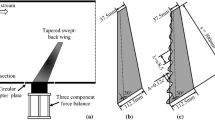Abstract
Inspired from the Humpback whale flipper, airfoils and wings incorporated with sinusoidal leading edge are much studied for their improved aerodynamic characteristics like delayed stall and higher lift in post-stall region. In this work, the performance of different swept wings equipped with leading edge tubercles is studied by comparing with their baseline models at a low Reynolds number of 100,000. Tubercles on swept wings can either be placed normal to leading edge or parallel to flow direction. First part of the study involves selecting the swept wing configuration which has superior aerodynamic performance from the two possible configurations based on the tubercle alignment on it. Wind tunnel experiment is conducted for the above-mentioned configuration of tubercles on different swept wings as well as unswept wing and compared to corresponding baseline wings. The orientation of tubercle relative to flow has a significance in aerodynamic performance. Aerodynamic efficiency is maximum when the tubercles are aligned with the flow direction. It is seen that tubercles on high swept wing are not as effective as it is on a unswept wing. On unswept and low swept, wing tubercles improve the stall characteristics by preventing abrupt stall and maintaining high lift in post-stall regime. The lift-to-drag ratio for these wings is improved when tubercles are introduced. However, for high swept, wing tubercles do not change the aerodynamic characteristics significantly.









Similar content being viewed by others
Abbreviations
- A :
-
Amplitude of tubercle
- \(C_{D}\) :
-
Coefficient of drag
- \(C_{L_\mathrm{max}}\) :
-
Maximum coefficient of lift
- \(C_{D_{i}}\) :
-
Coefficient of induced drag
- c :
-
Mean chord
- D :
-
Drag force
- L :
-
Lift force
- \({(L/D)}_\mathrm{max}\) :
-
Maximum lift-to-drag ratio
- S :
-
Span of wing
- W :
-
Wavelength of tubercle
- Re :
-
Reynolds number
- \(\alpha\) :
-
Angle of attack
- \(\alpha _\mathrm{stall}\) :
-
Stall angle
- \(\beta\) :
-
Angle between flow direction and direction of tubercle
- \(\lambda\) :
-
Swept angle of wing
References
Anderson J (1991) Fundamentals of aerodynamics
Bechert D, Bruse M, Hage W, Meyer R (2000) Fluid mechanics of biological surfaces and their technological application. naturwissenschaften 87(4):157–171
Bhushan B (2012) Shark skin surface for fluid-drag reduction in turbulent flow. In Biomimetics. Springer, pp 227–265
Bolzon M, Kelso R, Arjomandi M (2014) The effects of tubercles on swept wing performance at low angles of attack. In Proceedings of the 19th Australasian fluid mechanics conference, pp 8–11. Australasian Fluid Mechanics Soc., Melbourne, Australia
Bolzon MD, Kelso RM, Arjomandi M (2017) Force measurements and wake surveys of a swept tubercled wing. J Aerospace Eng 30(3):04016085
Coleman HW, Steele WG (1995) Engineering application of experimental uncertainty analysis. AIAA J 33(10):1888–1896
Custodio D (2007) The effect of humpback whale-like leading edge protuberances on hydrofoil performance. Worcester Polytechnic Institute
DeYoung D, Hobbs D (2009) Discovery of design: searching out the creator’s secrets. New Leaf Publishing Group
Edel R, Winn H (1978) Observations on underwater locomotion and flipper movement of the humpback whale megaptera novaeangliae. Mar Biol 48(3):279–287
Fish F, Lauder G (2006) Passive and active flow control by swimming fishes and mammals. Annu Rev Fluid Mech 38:193–224
Fish FE, Battle JM (1995) Hydrodynamic design of the humpback whale flipper. J Morphol 225(1):51–60
Fish FE, Howle LE, Murray MM (2008) Hydrodynamic flow control in marine mammals. Integr Comp Biol 48(6):788–800
Hansen KL, Kelso RM, Dally BB (2011) Performance variations of leading-edge tubercles for distinct airfoil profiles. AIAA J 49(1):185
Johari H, Henoch CW, Custodio D, Levshin A (2007) Effects of leading-edge protuberances on airfoil performance. AIAA J 45(11):2634–2642
Kapsali V et al (2016) Biomimetics for designers. Thames & Hudson, London
Miklosovic D, Murray M, Howle L, Fish F (2004) Leading-edge tubercles delay stall on humpback whale (megaptera novaeangliae) flippers. Phys Fluids 16(5):L39–L42
Pedro HC, Kobayashi M (2008) Numerical study of stall delay on humpback whale flippers. In 46th AIAA aerospace sciences meeting and exhibit, pp 584
Stein B, Murray M (2005) Stall mechanism analysis of humpback whale flipper models. Proceedings of Unmanned Untethered Submersible Technology (UUST), UUST05 5
Watts P, Fish F (2006) Scalloped leading edge advancements. US Patent App. 11/093,722
Watts P, Fish FE et al (2001) The influence of passive, leading edge tubercles on wing performance. In Proceedings of twelfth international symposium unmanned untethered submersible technology, Autonomous Undersea Systems Institute, Durham New Hampshire
Weber PW, Howle LE, Murray MM (2010) Lift, drag, and cavitation onset on rudders with leading-edge tubercles. Marine Technol 47(1):27–36
Wei Z, New TH, Cui Y (2017) Aerodynamic performance and surface flow structures of leading-edge tubercled tapered swept-back wings. AIAA J, PP 423–431
West G, Apelt C (1982) The effects of tunnel blockage and aspect ratio on the mean flow past a circular cylinder with reynolds numbers between 10 4 and 10 5. J Fluid Mech 114:361–377
Acknowledgements
Authors would like to acknowledge the financial support extended by the Science & Engineering Research Board (SERB), India (Sanction order: EMR/2015/000879) to carry out this research work.
Author information
Authors and Affiliations
Corresponding author
Rights and permissions
About this article
Cite this article
Joseph, J., Sathyabhama, A. Experimental Study on the Effect of Tubercle on Aerodynamic Characteristics of Swept Wings at low Reynolds Number. Iran J Sci Technol Trans Mech Eng 46, 783–792 (2022). https://doi.org/10.1007/s40997-021-00455-z
Received:
Accepted:
Published:
Issue Date:
DOI: https://doi.org/10.1007/s40997-021-00455-z




